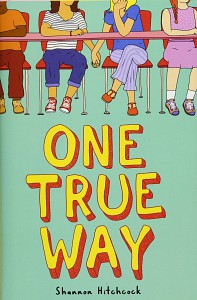It is so exciting to experience the current burgeoning of middle LGBTQ fiction: it feels absolutely amazing (not to mention freeing) to have enough books out there to be able to pick and choose and categorize, and set aside what misses the mark in favor of reading the good stuff. Shannon Hitchcock’s One True Way is the good stuff.
After the death of her brother and her parents’ subsequent separation, Allie moves to North Carolina with her mom, hoping for a fresh start in the fall of 1977. Despite being the new girl at Daniel Boone Middle School, she quickly finds her footing, thanks to the kindness of Sam, the easygoing star basketball player who is friends with everyone. As an intrepid would-be reporter writing for the school newspaper, Allie is no stranger to asking tough questions–but she has to turn her gaze inward as her deepening relationship with Sam brings up questions she must ask herself–and Sam–and new feelings she has to navigate, while trying to figure out what kind of support they can get from the adults around them.
Coming out stories may be more oversaturated in fiction and pop culture geared toward adults and young adults, but a middle grade story like this (especially one that is so well-written, thoughtful, and tender) is nothing less than stunning–especially one starring a 12-year-old girl, set in the 1970s, and in North Carolina no less. This kind of historical fiction is sorely needed representation for today’s queer youth–and One True Way is all the more special for the representation it skillfully weaves in for its protagonist. Allie has a strong network of adult queer role models, from her Uncle Jeffrey, who is mentioned in passing, to Coach Murphy and Miss Holt, two teachers at her school who are quietly in a relationship with one another (and are friends with her mom). Hitchcock has built a world that reflects a possible reality–one that is neither maudlin nor saccharine, that showcases beautiful, unabashed queerness in many forms without shying away from depicting the existence of harsh realities (unaccepting family members, intolerant religious institutions, an inability be out for fear of losing one’s job…) for her queer characters.
Today’s queer youth deserve tender historical fiction about a girl and her new best friend realizing they have crushes on one another–with all the ensuing teenage angst, and a decent portrayal (without being gloomy or heavy-handed) of some of the serious aspects of being a queer middle schooler in the South in the 1970s. And even more than its portrayal of a queer love story, One True Way’s portrayal of queer community is a bold and important statement to share with queer and questioning middle schoolers. While I so wish I had had books like this growing up, I am so grateful that today’s kids have works like this to read (and have even more to choose from, depending on what tickles their fancy!): One True Way fills a much-needed niche, and beautifully so.

